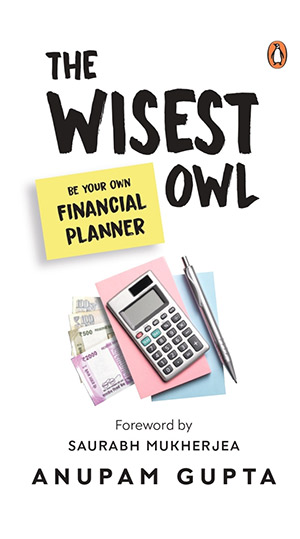An excerpt from Anupam Gupta’s new book, ‘The Wisest Owl – Be Your Own Financial Planner’
Anupam Gupta’s new book, ‘The Wisest Owl – Be Your Own Financial Planner’ (Penguin), uses the wisdom and experience of India's top personal finance professionals – Dilshad Bilimoria, Harsh Roongta, Lovaii Navlakhi, Melvin Joseph, Suresh Sadgopan, Vishal Dhawan and Shalini Dhawan – to offer a framework readers can use to create wealth in the long run.
‘The Wisest Owl’ will help general business readers including students and home makers by offering them a framework they can use to create wealth in the long run. This book includes interviews with India’s top wealth managers and personal finance experts.
 Having reached the middle-income status as a country, India is witnessing a major change in the way we look at money. A vast section of the youth is now aspiring for higher financial goals. This large population is breaking away from its parents in almost every way, including financially. But the new generation of Indians entering the workforce demands more guidance on their investments. They constantly grapple with complicated questions surrounding money: What do they do with their money? How do they plan for their future? Most of the time, they get bad advice. Mutual funds have not really delivered meaningful returns, stock selection is extremely complicated and sophisticated investments like PMS, AIF, etc., are only for the wealthy.
Having reached the middle-income status as a country, India is witnessing a major change in the way we look at money. A vast section of the youth is now aspiring for higher financial goals. This large population is breaking away from its parents in almost every way, including financially. But the new generation of Indians entering the workforce demands more guidance on their investments. They constantly grapple with complicated questions surrounding money: What do they do with their money? How do they plan for their future? Most of the time, they get bad advice. Mutual funds have not really delivered meaningful returns, stock selection is extremely complicated and sophisticated investments like PMS, AIF, etc., are only for the wealthy.
This book tries to help these young investors by offering them a framework they can use to create wealth in the long run. Using the wisdom and experience of India's top personal finance professionals, the book answers some critical questions, such as: Should I rent or buy a house? Is passive investing better than active investing? Are stocks more lucrative than mutual funds? Do debt funds generate better returns than FDs? And finally: Crypto or no crypto?
Gupta, a chartered accountant, author and podcast host, worked for two decades as an investment research analyst and as a thematic research consultant in institutional equities with leading brokerages such as CLSA, HDFC Securities, Barclays and Ambit Capital. In 2020, he, with Saurabh Mukherjea, co-authored the bestselling book, ‘The Victory Project: Six Steps to Peak Potential’. Since 2017, he has been hosting ‘Paisa Vaisa’, a free-to-air personal finance podcast available on all podcasting platforms. ‘Paisa Vaisa’ has nearly 2 million downloads and won the Best Business Podcast award at the Asia Podcast Awards held in 2019.
Here is an excerpt from ‘The Wisest Owl’:
Kal, Aaj Aur Kal
To understand where India is today, it’s important to understand where we’ve come from. Today we take investing in shares of Apple, Facebook, Google, etc., for granted, whereas this was not even possible a few decades ago for a variety of reasons ranging from regulation to lack of customer-friendly technology. Opening a brokerage account, a bank account, or starting a mutual fund SIP—all of these can happen sitting at home, with your smartphone. We’ve indeed come a long way from standing in line (Adajania, 2013) to invest in the Morgan Stanley Growth Fund in 1994. Ideas of risk and return have evolved over decades from the stock market as a gambler’s den to an SIP in an equity mutual fund being a serious tool for long-term wealth creation. This chapter gives some background on how investment products evolved in India and helps you understand the profound change that I describe in the next chapter.
Elon Musk famously tweeted, ‘Who controls the memes, controls the Universe.’ Generation X-ers like me didn’t have memes in our childhood to help us understand things better (or to make fun of things). So, I can understand how those of my generation struggle to understand their kids who feed on memes day in, day out. Memes are a great sign of the generation gap that exists today between Generation X, Millennials and Generation Z (if you follow the Pew Centre). I recommend readers to go through Buzzfeed’s list of ‘41 Things That Are Just Too Damn Real If You Have Indian Parents’ to understand this generation gap and to have a good laugh at some of the memes. One tweet reads, ‘Desi parents never actually bought new batteries for the TV remote. They’d just slap the shit out of it hoping it’d start working again and then blame u for watching too much TV.’ So, if you don’t have a good laugh or—worse—don’t understand the meme, then you know which side of the gap you’re on. Another way to understand this generation gap is to watch the web series ‘Tech Conversations with My Dad’. Made by the brilliant The Viral Fever (TVF), the series is free to air and consists of short (under eight minutes) hilarious videos featuring a son (Jitendra Kumar) explaining technology to his father (Gajraj Rao).
Kids today are growing up with choices, whereas their parents grew up in an India with compulsions, and their grandparents in an impoverished India with severe constraints. A twenty-five-year-old working in the 1970s had to wait in line for years to get a scooter and a landline phone. A twenty-five-year-old working in the 1990s had to be careful about outstation calls and enjoyed a fuel-efficient four-stroke motorcycle. A twenty-five-year-old working in the 2020s has 1–2GB/day mobile data and can choose between an electric two-wheeler and, say, a stylish gearless scooter. Consumer choices apart, my generation (those born in the early 1970s) can understand their parents’ obsession with buying a house to secure a roof over one’s head and stick with the same job for most of their career. But today’s generation believes in rent, the gig economy and taking career breaks. This attitude towards work and towards life changes the very idea of risk (in life and with investments) and return (in terms of expectations from life and from investments). So, generation gaps are stark for every generation but when it comes to money, this generation is more distant than the previous ones.
Memes are just one way to gauge how wide this generation gap is today. But since this book is about personal finance and not pop culture, it’s important for readers to know how financial products developed in India post Liberalization to appreciate the depth of change in products and attitudes in the past decade.
Describing the generation gap, Shalini Dhawan, a SEBI RIA whose interview is in Chapter 6 of this book, told me, ‘We have clients where we work across three generations (grandparents, parents, children), so we can share some anecdotes. The senior (retired) generation has wealth but is still in wealth-preservation mode. Our planning and simulations show they are comfortable but when we tell them that they can enjoy and spend, they tell us that they’d rather leave that money for the next generation. The next generation (fifty-year-olds and above) are in a midlife crisis. After working hard for decades, they’re wondering if they should plunge into entrepreneurship or explore an early retirement. They have many goals (taking care of their parents, taking care of their children) to be met so it’s about what are the trade-offs they may have to do. The next generation (twenty-year-olds) is still exploring money. Unlike their parents or grandparents, these kids are not deprived of wealth. So, they’ve not faced the same situations as their previous two generations and—as planners—we help them balance their priorities. This is a new India that we’re seeing, and it will be interesting to see how it evolves.’
Suresh Sadagopan, a SEBI RIA whose interview is in Chapter 5, told me, ‘The generations before were literally living in a different age. In that time, the options were really limited. There were fixed deposits, bonds, small savings instruments and some basic insurance plans. And they were very attractive because interest rates were high in those days. When the returns were so good, there was no incentive to take
risks unnecessarily into equities.’
[Excerpt reproduced with permission of the publishers.]
